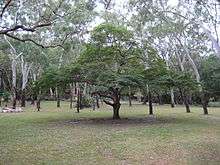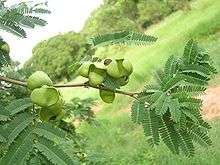Libidibia coriaria
Libidibia coriaria is a leguminous tree or large shrub native to the Caribbean, Mexico, Central America, and northern South America. Common names include Divi-divi, Cascalote, Guaracabuya, Guatapana, Nacascol,[1] and Watapana (Aruba).
| Libidibia coriaria | |
|---|---|
 | |
| Divi-divi on Aruba | |
| Scientific classification | |
| Kingdom: | |
| (unranked): | |
| (unranked): | |
| (unranked): | |
| Order: | |
| Family: | |
| Genus: | |
| Species: | L. coriaria |
| Binomial name | |
| Libidibia coriaria (Jacq. 1763) Schltdl. 1830 | |
| Synonyms[1] | |
| |
Description

L. coriaria rarely reaches its maximum height of 9 m (30 ft) because its growth is contorted by the trade winds that batter the exposed coastal sites where it often grows. In other environments it grows into a low dome shape with a clear sub canopy space. Leaves are bipinnate, with 5–10 pairs of pinnae, each pinna with 15–25 pairs of leaflets; the individual leaflets are 7 mm long and 2 mm broad. The fruit is a twisted pod 5 cm (2.0 in) long.
The Divi-divi is one of the more well known species of Libidibia; it is the national tree of Curaçao.[2] It is also very common and popular on Aruba.

Chemistry
Tannins are extracted from Divi-divi pods for use in leather production.[3][4]
Among the molecules isolated is corilagin, whose name comes from the specific epithet of the plant.
References
- "Caesalpinia coriaria". Germplasm Resources Information Network (GRIN). Agricultural Research Service (ARS), United States Department of Agriculture (USDA). Retrieved 2011-04-18.
- Sullivan, Lynne M. (2006). Adventure Guide to Aruba, Bonaire & Curaçao. Hunter Publishing Inc. p. 10. ISBN 978-1-58843-572-9.
- "Vegetable tannins". Bookbinding and the Conservation of Books. Conservation OnLine. 2011-03-10. Retrieved 2011-04-18.
- Perez-Tello, Carlos (1995). "Recovery of Vegetable Tannins from Divi-divi Pods". Journal of Chemical Technology & Biotechnology. 64 (1): 101–104. doi:10.1002/jctb.280640116.
External links

